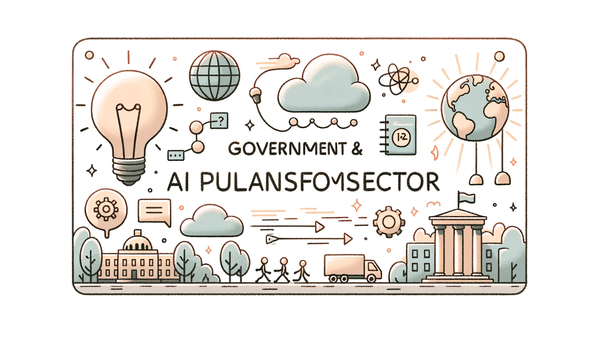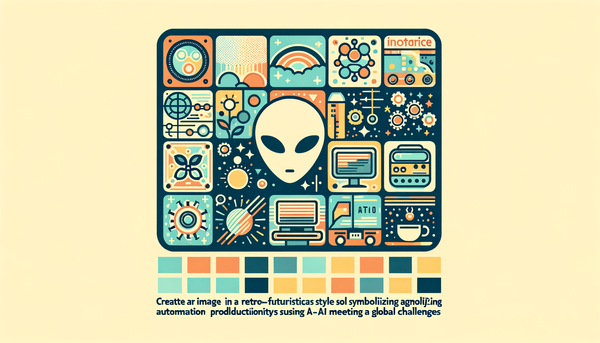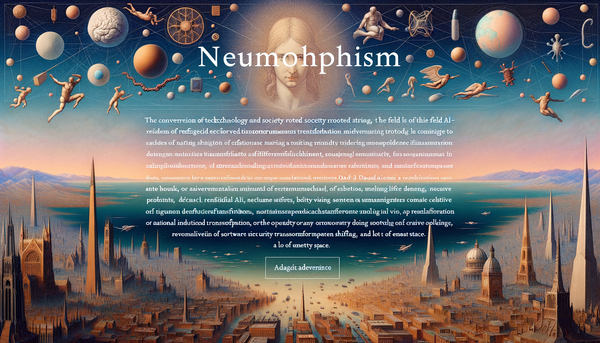Emerging Trends in Generative AI Management and Its Impact
Artificial Intelligence is no longer a vision of the future—it’s an ever-evolving force that is reshaping education, healthcare, consumer technology, management, and even entertainment, proving that innovation spares no avenue.
AI in Education: HBCUs as Trailblazers in Innovative Learning
Standing at the intersection of tradition and modernity, historically black colleges and universities (HBCUs) are emerging as incipient hubs of AI-driven educational reform. Although one of the recent articles titled "The Future of AI: How HBCUs are Leading Innovation in Education" does not detail its summary explicitly, the topic alone speaks volumes. In today’s dynamic academic environment, HBCUs are leveraging AI not merely to streamline administrative tasks but to reimagine pedagogy built on personalized learning, real-time feedback, and deep data analytics.
Institutional leaders in these centers are working with cutting-edge technologies to design curricula that incorporate machine learning algorithms, natural language processing, and even computer vision. Their focused research agendas are ensuring that students—often underrepresented in discussions about technology—gain early exposure to the powering forces behind modern digital transformation.
This surge in AI integration is not isolated. Across the nation, educational institutions are championing solutions that democratize learning. I recall a conversation with a professor who said,
"By integrating AI tools, we are not replacing educators; we are augmenting their abilities to inspire critical thinking in every student."
AI not only enhances traditional roles but also opens exciting avenues for interdisciplinary research.
For those seeking to explore how AI reshapes academia further, our detailed coverage of AI innovations transforming industries and education on AI.Biz offers great insights.
Next-Generation Healthcare: Rethinking EHRs through the Lens of AI
Healthcare stands on the cusp of its next revolution—a shift powered by AI-enhanced Electronic Health Record (EHR) systems. In the piece "NextGen taking a new look at EHRs through the eyes of AI" published by Healthcare IT News, we are prompted to consider how digitized records, when combined with machine learning, can aid in predictive diagnostics, reduce physician burnout, and optimize patient care. While the summary for this article is not provided, its title indicates a drive towards efficiency, safety, and patient-centric care.
By deploying advanced algorithms, healthcare providers can mine vast patient data to identify patterns often invisible to the human eye. For instance, early detection of comorbidities and risk factors for chronic illness becomes more feasible, ushering in a new era of prevention. Recent research published in peer-reviewed journals has consistently underscored that AI-based models are significantly enhancing the accuracy of EHR-based predictions.
This transformation invites both caution and optimism. As one leading expert famously noted,
"By far the greatest danger of Artificial Intelligence is that people conclude too early that they understand it." (Eliezer Yudkowsky)
Such insights remind us that while embracing innovation, it is crucial to validate and regulate these advancements meticulously.
AI-driven EHR systems aren’t just reprocessing patient data; they are fostering a more holistic approach to patient care. For more detailed analysis on how AI is reshaping healthcare practices, visit our article on AI tools transforming healthcare and academia.
Revolutionizing Consumer Technology: TECNO and the AI-Powered Future
In the fast-paced world of consumer gadgets, innovation isn’t a buzzword—it’s the benchmark. TECNO made a splash at MWC 2025 with its Camon 40 series launch, a prime example of how smartphones are morphing into sophisticated AI platforms. Central to this series is the Camon 40 Premier 5G, which is powered by the impressive MediaTek Dimensity 8350 Ultimate chip. This device not only captures images with a 50MP Sony LYT-701 sensor but also utilizes advanced AI capabilities such as FlashSnap technology to rapidly capture movement with stunning clarity.
Beyond the smartphone, TECNO unwrapped its foray into wearable tech with the announcement of AI smart glasses. Designed for a tech-savvy generation, these glasses come equipped with a 50MP camera, boasting object recognition, real-time display features for navigation, and even multilingual translation through its Ella AI assistant. With features supported by robust battery life and water resistance ratings, these products are perfect for the intrepid user who demands both style and substance without compromising on performance.
The integration of AI in photography and real-world usability in the Camon 40 series is a nod to an industry that is eager to reconcile high-performance technology with everyday practicality. Devices such as these underscore how AI can elevate even routine tasks, bridging the gap between consumer expectations and futuristic innovation. As we witness rapid advancements, it is inevitable to draw parallels with earlier developments seen in our coverage at NetSuite’s expansion of AI capabilities.
My own experience with early AI-driven photography apps reinforces the potential these technologies have to transform the everyday. It’s a fusion where technical prowess meets the art form of capturing moments, making everyday experiences richer and profoundly integrated with tech.
AI in Human Resources: The Emergence of the Generative AI Management Consultant
The management consulting landscape is witnessing an intriguing paradigm shift with the introduction of generative AI consultants. The article, "As technology evolves, a new title emerges: Generative AI management consultant" featured by HR Dive, highlights how artificial intelligence is beginning to assist companies in strategic decision-making. These AI entities are capable of analyzing vast datasets, generating insights, and even simulating scenarios, offering a new dimension to the role traditionally held by human consultants.
Generative AI can digest a combination of market research, financial statistics, and even human behavioral data to propose viable business strategies. While some purists might argue that AI could eventually reduce the role of human judgment, others believe that the AI consultant serves as an essential augmentative tool. AI-driven insights empower human consultants to focus on more creative, strategic challenges rather than spending time crunching numbers—a sentiment echoed in many modern business debates.
Particularly noteworthy is the way industries are beginning to adapt AI to solve intricate problems with unprecedented speed and precision. Imagine a boardroom where sentiments are cross-referenced with market trends in real time—this is the promise of generative AI. For a more detailed look at how AI continues to integrate into various sectors, our article on AI developments and innovations in various sectors provides fascinating insights.
AI-Powered Chatbots: Addressing the High School Counselor Shortage
A topic that has recently garnered attention is the potential role of AI chatting tools in mitigating the shortage of high school counselors. As detailed in "AI chatbots can cushion the high school counselor shortage — but are they bad for students?" from The Santa Rosa Press Democrat, there is a growing debate regarding the balance between automated interaction and human empathy in educational settings.
In an era where digital solutions are proliferating, schools are exploring AI chatbots that can offer basic mental health support and academic guidance. These systems promise to provide immediate responses to student queries, helping identify early signs of distress, and ensuring that no student feels isolated during critical transition periods. Nonetheless, the complexity of human emotion and the quality of support required reveal that AI chatbots must be integrated with robust human oversight to avoid potential pitfalls.
Anecdotes from educators reveal that while chatbots can handle logistical queries efficiently, the nuances of human psychology may still require the human touch. Though technology ushers in efficiency, the emotional support provided by trained professionals remains irreplaceable. This caution resonates with the broader theme of ensuring that technological advancements bolster rather than replace human expertise.
Gaming, Entertainment, and AI: The Curious Case of Call of Duty's Delay
Not all discussions on AI are confined to education, healthcare, or enterprise solutions. Even the gaming industry, a realm synonymous with cutting-edge technology, finds AI playing a vital role. A recent report from TechRadar on "Call of Duty: Black Ops 6 Season 3 gets two-week delay, will now release in April" reveals an intriguing narrative. Although the piece focuses on game release timelines, it indirectly highlights the technological intricacies involved in delivering a polished gaming experience.
The delay stems from Activision’s commitment to quality, ensuring that AI-driven features such as realistic in-game physics, enhanced enemy behavior, and dynamic environmental settings operate flawlessly before the public rollout. Notably, advanced AI routines are behind many popular features in modern games, such as responsive non-player characters (NPCs) that react organically to players’ actions and campaigns that adjust difficulty in real time.
As gamers eagerly await the return of classic maps like Verdansk and themed crossover events (including creative ventures with pop culture icons like the Teenage Mutant Ninja Turtles), this instance reinforces that AI’s influence extends far beyond industrial applications. Technology and entertainment, when fused, produce immersive experiences that captivate diverse audiences. For enthusiasts who enjoy exploring how AI is affecting various sectors, our site also covers broader topics in AI, such as innovative uses in space exploration and beyond here.
Telecommunication Breakthroughs: AI-for-RAN in the 5G Era
Another riveting development is unfolding in the telecom sector where Keysight and Samsung, in collaboration with NVIDIA, are advancing AI-for-RAN (Radio Access Network) capabilities. Although the article "Keysight and Samsung Advance AI-for-RAN Based on the NVIDIA AI Aerial Platform" provides no extensive summary in the provided excerpt, the implications are monumental.
Integrating AI with wireless communications heralds a new epoch where networks can self-optimize, predict user demand, and dynamically adjust for peak performance. With 5G technology already in place, AI enhances network analysis and problem resolution, dramatically reducing downtime and improving service delivery. This transition is particularly relevant in our digital age, where connectivity is not just a luxury, but a backbone of modern society. It's reminiscent of the early days of the Internet, where challenges in scalability and security prompted rapid innovation. Today, the telecommunication sector faces a similar evolution—with AI at its helm.
This progression is further supported by ongoing research in adaptive network designs and intelligent traffic management, ensuring that as consumers demand higher speeds and more reliable connectivity, networks are prepared to meet these challenges. The symbiotic relationship between AI and telecommunications continues to promise a future with significantly fewer interruptions and robust performance metrics.
Reflections on the Broader AI Landscape
As someone who’s closely observed the evolution of technology over the years, I can say that we are witnessing an inflection point in human progress. AI is bridging gaps in understanding, streamlining systems, and even enhancing creative outputs. I often recall the words of Fei-Fei Li who once envisioned a world where "AI is going to make us work more productively, live longer, and have cleaner energy." Such predictions, once the realm of science fiction, are now tangible realities reshaping numerous sectors.
This sweeping impact of AI is reflected in diverse industries—from the integration of sophisticated algorithms in HBCUs to transform the educational experience, to next-gen EHR systems revolutionizing healthcare, and even to the consumer tech arena where products like TECNO's Camon 40 and AI smart glasses are redefining everyday technology. Even as generative AI becomes the new frontier in management consulting, bridging the gap between big data and business strategy, innovation continues to reach into unexpected areas like digital entertainment and telecommunication.
The pace of technological advancement is sometimes dizzying. I remember reading a rather thought-provoking remark by A.R. Merrydew:
"If you could travel back in time, you would miss out on all of the mistakes you made. You would undoubtedly be someone very different. Long live my past and my mistakes."
This resonates strongly in the AI sphere—acknowledging that each misstep and each triumph propels us forward, building a future where technology and humanity are more deeply intertwined.
Experts suggest that understanding AI demands both humility and vision, recognizing that innovations often entail incremental progress punctuated by occasional leaps. The synergy achieved when humans collaborate with AI is perhaps best exemplified by cross-sector advancements, where improvements in one domain inadvertently accelerate progress in another.
In this context, it's essential to note that while each new application of AI may seem to exist in its silo, there is an undeniable interconnectedness. For instance, the lessons learned in deploying AI in health care inform best practices in educational settings; breakthroughs in wearable technology push further the boundaries in mobile computing and user interaction; and strategic insights from generative AI consultants are also applicable in managing complex digital ecosystems in entertainment and telecommunications.
Integration and Future Prospects
Looking ahead, the application of AI across a multitude of sectors offers a compelling narrative for sustained innovation and progress. Development in AI is not merely about optimizing existing procedures but about rethinking how systems function at their core. HBCUs leading in AI research and development symbolize a broader movement towards creating inclusive innovation ecosystems where diverse perspectives drive creative solutions. As educators integrate AI to offer personalized learning experiences, they forge a path that inspires future generations to think beyond conventional boundaries.
In the healthcare arena, AI-powered EHR systems not only improve operational efficiency but create possibilities for more patient-centered models of care. When combined with deep learning and data analytics, these systems are poised to detect and prevent medical issues before they escalate, which could dramatically reduce healthcare costs and improve quality of life.
The consumer technology sector, as seen with TECNO's latest releases, demonstrates that AI is rapidly permeating the gadgets we use every day. The ability to harness AI in mobile devices and wearable tech signifies a step beyond mere convenience; it leverages profound computational intelligence to enhance human creativity and utility. There is a growing symphony of devices that not only respond intelligently but also predict the needs of the user—a trend that promises even more immersive and interactive experiences in the near future.
Moreover, the rise of AI consultancies and the integration of AI in strategic business planning highlight a transformation in corporate governance. These advancements reduce operational inefficiencies and offer unprecedented insight into market dynamics, fueling more accurate decision-making. As management consultants harness the power of AI, companies around the world are better equipped to navigate the complexities of modern markets.
AI’s influence in gaming and entertainment, exemplified by the careful calibration of releases such as Call of Duty: Black Ops 6 Season 3, also underscores how technology is being employed to ensure optimal consumer experiences. Here, quality is paramount, and the application of AI is a testament to the industry’s commitment to excellence.
In telecommunications, the emergence of AI-for-RAN reinforces the idea that connectivity and communication are set to become more resilient and adaptive than ever before. As networks incorporate intelligent analytics and predictive mechanisms, they will not only provide high-speed connectivity but will also be capable of self-healing and optimization in real time.
The continuous push in research and innovation across these domains is a testament to the limitless applications of AI. In essence, each breakthrough encourages a reimagining of what’s possible, often inspiring interdisciplinary solutions that unlock unforeseen potentials. The convergence of diverse AI applications hints at a future where boundaries between sectors blur, leading to a holistic upgrade of societal infrastructure powered by machine intelligence.




